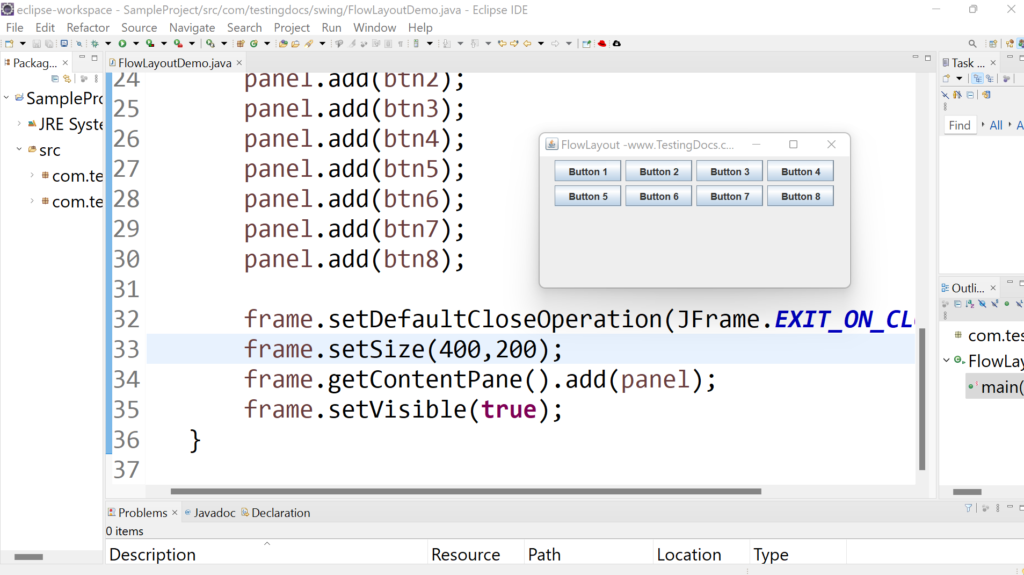
Import the required classes from the java. Here are a few examples of using AWT to create basic GUI interfaces: This is achieved by using the underlying operating system's native GUI components, and abstracting the differences between different platforms.ĪWT is still widely used today, particularly for applications that require a simple and straightforward GUI. AWT was designed to provide a consistent look and feel across different operating systems, allowing developers to write once and run anywhere. One of the key features of AWT is its cross-platform compatibility. AWT provides a set of basic components and widgets, such as buttons, labels, text fields, and more, that developers can use to create simple GUI interfaces. The Abstract Window Toolkit (AWT) was introduced as part of Java's standard library in its early days and was the first GUI library for Java.

It lays the components in the order they are added to the container. It lays out the components horizontally, and then vertically. By the end of this blog, you will have a solid understanding of GUI development in Java and be able to create your own GUI interfaces with confidence. The FlowLayout is the simplest layout manager in Swing. We will also cover important concepts such as layout management, event handling, and working with images and media. In this blog, we will explore the basics of GUI development in Java, including the history of Java's GUI libraries, and delve into the key features and examples of using the Abstract Window Toolkit (AWT), Swing, and JavaFX.
JAVA SWING FLOWLAYOUT EXAMPLE SOFTWARE
Over the years, Java's GUI libraries have evolved to cater to the changing needs of software development, and today, Java offers some of the most advanced and sophisticated GUI libraries available. How can I remove the gap between the two FlowLayout (So itll be like the blue gap) java swing.
JAVA SWING FLOWLAYOUT EXAMPLE DOWNLOAD
The following figure represents a snapshot of an application that uses the flow layout: Click the Launch button to run FlowLayoutDemo using Java Web Start ( download JDK 7 or later ). If the horizontal space in the container is too small to put all the components in. If I insert a JButton for example, it works fine (It inserts them with no gap). The FlowLayout class provides a very simple layout manager that is used, by default, by the JPanel objects. Java, one of the most popular programming languages in the world, provides several libraries for GUI development. The FlowLayout class puts components in a row, sized at their preferred size. It is part of Oracle’s Java Foundation Classes (JFC) an API for providing a graphical user interface (GUI) for Java programs. GUI has become an indispensable aspect of software development, making it easier for users to perform tasks and interact with the computer. Java Swing FlowLayout Example Jyoti Jha November 7th, 2016 Last Updated: November 5th, 2016 0 96 5 minutes read Swing is a GUI widget toolkit for Java.

Once executing this java program, Frame with flow layout buttons will be popped up as above and closes if we. Flow layouts are typically used to arrange buttons in a. It provides a visual interface for users to interact with the computer and access its functions and features. Example Java Program for JFrame FlowLayout (GUI). A flow layout arranges components in a left-to-right flow, much like lines of text in a paragraph. Graphical User Interface (GUI) is an essential part of modern software development. SwingUtilities.In this article, we learn about GUI in Java with Java AWT, Swing, JavaFX, and some other relevant concepts. Next, we will add these components to the container, JFrame.The object of FlowLayout class, which sets the position of the components in JFrame as per the positioning defined by FlowLayout manager. It is the default layout manager for the JPanel component. So, we will call setLayout() method of JFrame class and pass it The FlowLayout manager is the simplest layout manager in the Java Swing toolkit. By default, JFrame uses the layout manager i.e. The flow layout manager arranges components in a row from left to right, starting a new row if no more components fit into a row.The object of their respective classes such as JLabel, JTextField, and JButton. In the upcoming code, we have going to create components such as - two labels, two text fields, and three buttons by creating.

An example display the use of FlowLayout manager


 0 kommentar(er)
0 kommentar(er)
